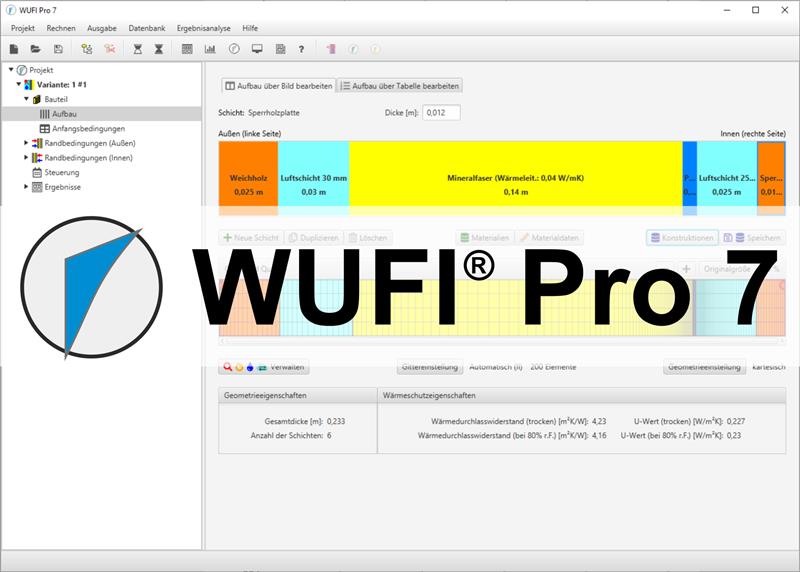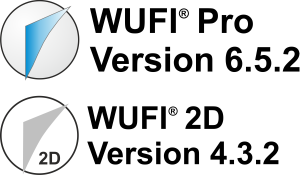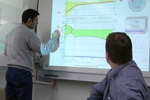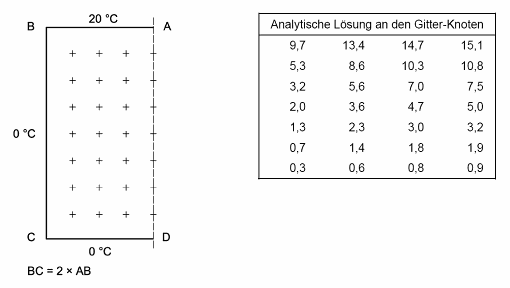Allgemein
RC4 – Release Candidate WUFI® Pro 7 test now!
 The new version WUFI® Pro 7 is now available for testing in a new look and with new features. We are working hard on the release, which will be available soon. Meanwhile we are offering the opportunity to test our release candidate in advance and try out the new features.
The new version WUFI® Pro 7 is now available for testing in a new look and with new features. We are working hard on the release, which will be available soon. Meanwhile we are offering the opportunity to test our release candidate in advance and try out the new features.
Here’s how to install the release candidate:
1. Download the archive here <Testperiod finished> and extract it.
2. Run the installation.
3. Start WUFI® Pro 7
A license window will appear – select “Trial version” and enter your name and email address – then you can get started.
Note for UK and Australia: To set your country-specific translation go to Project – Settings and select your countries English from the list.
Release Candidate WUFI® Pro 7 now available for testing
 The new version WUFI® Pro 7 is now available for testing in a new look and with new features. We are working hard on the release, which will be available soon. Meanwhile we are offering the opportunity to test our release candidate in advance and try out the new features.
The new version WUFI® Pro 7 is now available for testing in a new look and with new features. We are working hard on the release, which will be available soon. Meanwhile we are offering the opportunity to test our release candidate in advance and try out the new features.
Here’s how to install the release candidate:
1. Download the archive here <Testperid finished> and extract it.
2. Run the installation.
3. Start WUFI® Pro 7
A license window will appear – select “Trial version” and enter your name and email address – then you can get started.
Please note: There is still a bug with the use of IP units. We are working on it.
Note for UK and Australia: To set your country-specific translation go to Project – Settings and select your countries English from the bottom of the list.
Release WUFI® Pro 6.5.2 and WUFI® 2D 4.3.2
 New versions of WUFI® Pro 6.5.2 and WUFI® 2D 4.3.2 with extended material and climate database are now available.
New versions of WUFI® Pro 6.5.2 and WUFI® 2D 4.3.2 with extended material and climate database are now available.
Users of WUFI® Pro 6 and WUFI® 2D 4 can download the update free of charge. You can use the link you received with your purchase of WUFI® Pro 6 or WUFI® 2D 4. You will also find the link in your account in our online shop under “My Orders”.
When buying a new license of WUFI® Pro or WUFI® 2D, you will receive the new version of WUFI® Pro 6.5.2 or WUFI® 2D 4.3.2.
Contine reading
New prices for WUFI® Pro from June 3rd 2019
From June 3rd 2019 we have to adjust our prices for WUFI® Pro:
| License | old | new | |
| WUFI® Pro 6 - 10 years | 2300 EUR | 2600 EUR | |
| WUFI® Pro 6 - 1 year | 850 EUR | 900 EUR | |
| Upgrade to WUFI® Pro 6 | 900 EUR | 950 EUR | |
Prices for multiple licenses and package prices change accordingly.
Until June 2nd you can still benefit from the old prices!
Release WUFI® Pro 6.3.2
 Version 6.3 of WUFI® Pro is now available.
Version 6.3 of WUFI® Pro is now available.
Users of WUFI® Pro 6 can download the update free of charge. You can use the link you received with your purchase of WUFI® Pro 6 and which is displayed in your account at our online shop in the “My Orders” menu.
When buying a new license of WUFI® Pro, you will receive the latest version WUFI® Pro 6.3.2.
New features and improvements in WUFI® Pro 6.3.2 are:
WUFI® Pro
- Extended check of entered material data
- Corrections in the climate dialogue
- Minor bugfixes and corrections
Contine reading
WUFI® Pro workshop in London – Still places available!
 There are still places available for the WUFI® Pro workshop in February 14th and 15th in London.
There are still places available for the WUFI® Pro workshop in February 14th and 15th in London.
Book now and save your seat.
- Impressions and further information here:
https://www.youtube.com/watch?v=wj-bM8XVi1Q - Follow this link for booking:
http://www.greenregister.org.uk/civicrm/event/info?reset=1&id=450 - More workshops:
https://wufi.de/en/service/workshops/#tab1
Two-dimensional test cases of ISO 10211
WUFI® 2D computes the time-dependent temperature and moisture fields in a two-dimensional cross-section of a building component. Such a two-dimensional computation automatically includes so-called geometrical and structural thermal bridge effects. These are the effects which the component shape (e.g. a corner) and variations of the thermal properties within the component (e.g. reinforcement bars) have on the resulting temperature field. The modifications of the temperature field and the associated heat flows by thermal bridges may have important consequences for energy loss, mold growth in damp corners etc.
WUFI® 2D is not intended to compete with dedicated thermal bridge programs which usually offer more flexible modelling interfaces and provide specific thermal bridge properties. But it can investigate the effect of thermal bridges on energy losses and, in particular, on the hygric conditions in and on building components (mold growth, damage due to condensation etc.), which purely thermal programs can not.
The international standard ISO 10211 provides a series of two- and three-dimensional test cases for validating thermal bridge software. Of course, WUFI® 2D should be able to reproduce the two-dimensional test cases.
Test case 1

Case 1 considers one half of a symmetrical square column with known constant surface temperatures. The steady-state temperature distribution over the cross-section can be computed analytically. 28 temperatures on an equidistant grid are given by the standard as the reference solution; the software to be validated must reproduce these temperatures within 0.1° C.
 The given boundary conditions (20° C along the top edge, 0° C along the left and bottom edges, and adiabatic along the right edge) result in a temperature field with strong variation close to the upper left corner and little variation towards the bottom of the cross-section.
The given boundary conditions (20° C along the top edge, 0° C along the left and bottom edges, and adiabatic along the right edge) result in a temperature field with strong variation close to the upper left corner and little variation towards the bottom of the cross-section.
Usually, one would therefore create a more efficient variable-size computational grid with fine grid elements close to the upper left corner and progressively larger grid elements towards the bottom. However, since for the present purpose the temperatures must be evaluated at precisely given coordinates and WUFI® computes the temperatures for the centers of the grid elements, a grid has to be created which ensures that a small element is centered at each of the requested positions.
To this end, the monolithic component has been built up from 28 separate blocks which fill up the space between the reference points and are subdivided by relatively coarse grids. The blocks are separated by 4 mm wide gaps which are subdivided by very fine grids in such a way that one small grid element is precisely centered on each reference point (one at each intersection of the gaps).
Since in the present case of a monolithic component with given surface temperatures the steady-state solution for the temperature field does not depend on the thermal properties, any arbitrary material data may be used. The data of concrete were chosen for this exercise.
The prescribed surface temperatures are applied to the component by setting the ambient air to the desired temperatures and the heat transfer coefficients for the surfaces to very large values. For the adiabatic right-hand surface (the symmetry plane which allows to limit the calculation to one half of the original square column), the heat transfer coefficient has been set to zero in order to suppress any heat exchange.
WUFI® 2D has no mode for steady-state solutions, but such a solution is approached to arbitrary precision if a transient computation with constant boundary conditions is performed for a sufficient number of time steps. Here, 10 steps of 48 hours each were found to be sufficient. Moisture transport was switched off for this purely thermal computation.
A graphical postprocessor for the calculation results allows to extract the final temperatures from any grid element. The comparison with the reference temperatures shows that WUFI’s temperatures deviate by 0.05° C or less and are thus well within the allowed deviation of 0.1° C.
You can download a WUFI® 2D project file (65 KB) for the benchmark calculation. Use the “Import…” function of WUFI® 2D to read this compressed archive file.
Test case 2


Case 2 considers the heat flow through a building component which contains materials with widely differing thermal conductivities.
| Dimensions (mm): | ||||||
| AB= 500 | CD = 15 | EM = 40 | IM = 1.5 | |||
| AC = 6 | CF = 5 | GJ = 1.5 | FG-KJ = 1.5 | |||
| Thermal conductivities (W/mK): | ||||||
| 1 (concrete): 1.15 | 2 (wood): 0.12 | 3 (insulation): 0.029 | 4 (aluminum): 230 | |||
| Boundary conditions: | |||
| AB: 0° C with Rse = 0.06 m²K/W | HI: 20° C with Rsi = 0.11 m²K/W | ||
The prescribed building component can easily be assembled from rectangles, using WUFI’s graphical component editor. The automatically generated grid with the fineness setting “coarse” is sufficient for this computation.
The thermal conductivities for the four involved materials are specified by the standard and have been entered in WUFI® accordingly. Since WUFI® needs a full set of thermal porperties for each material (including heat capacity etc.) the missing data have been taken from similar materials in WUFI’s material database. The steady-state result only depends on the prescribed thermal conductivities, not on the added properties.
The ambient air temperatures and the heat transfer coefficients for the top and bottom surfaces are entered in WUFI® 2D as specified by the standard. The left and right surfaces are treated as adiabatic by setting the respective heat transfer coefficients to zero.
In this case, too, the steady-state solution must be approximated by a transient calculation with constant boundary conditions. 30 steps of one hour each were found sufficient.

The resulting temperatures at the specified locations can again be extracted with the graphical postprocessor. However, the standard asks for temperatures on material boundaries whereas WUFI® computes the temperatures for the centers of the grid elements and any material boundaries must always coincide with boundaries between grid elements. So in this case it is not possible to center grid elements on the requested locations (such grid elements would contain two or more different materials which is not allowed).
Close to the four corners (points A, B, H and I), the temperature variation is so small that the center of the outermost grid element instead of the true geometric corner can be taken as sufficiently representative.
Where the requested location lies between two materials (points C, E and F), the temperature at this location must be computed from the temperatures at the centers of the two grid elements straddling the location. The temperature ϑm for a location m between locations 1 and 2 can be computed by ϑm = ((λ1/s1) ϑ1 + (λ2/s2) ϑ2) / ((λ1/s1)+(λ2/s2)), where ϑi is the temperature at location i, λi is the thermal conductivity between locations i and m, and si is the distance between locations i and m. Since the grid elements straddling a material boundary all have the same size, the si cancel and the expression reduces to ϑm = (λ1 ϑ1 + λ2 ϑ2) / (λ1+λ2).
For locations where three materials meet (points D and G), the temperature has been computed from the temperatures in the four adjacent grid elements by the following generalisation of the above formula: ϑm = (λ1 ϑ1 + λ2 ϑ2 + λ3 ϑ3 + λ4 ϑ4) / (λ1 + λ2 + λ3 + λ4).
The comparison with the reference temperatures shows that WUFI’s temperatures deviate by 0.1° C or less and are thus within the allowed deviation of 0.1° C. The heat flow through the component is 9.5 W/m and thus within the required (9.5 ± 0.1) W/m.
You can download a WUFI 2D project file (30 KB) for the benchmark calculation. Use the “Import…” function of WUFI® 2D to read this compressed archive file.
Last Update: December 22, 2025 at 11:45
Benchmark test of EN 15026
European standard EN 15026 provides minimum criteria for simulation software used to predict one-dimensional transient heat and moisture transfer in multi-layer building components exposed to transient climate conditions on both sides.
The standard lists model equations and pertinent material properties which shall be used for computing heat and moisture transport phenomena. These model equations allow for the following storage and transport phenomena:
- heat storage by the dry materials and the absorbed water,
- heat transport by moisture-dependent thermal conduction,
- latent heat transfer by vapor diffusion,
- moisture storage by vapor sorption and capillary forces,
- moisture transport by vapor diffusion,
- moisture transport by liquid transport (surface diffusion and capillary flow),
and the following boundary conditions:
- indoor and outdoor temperature,
- indoor and outdoor humidity,
- solar and long-wave radiation,
- precipitation (normal and driving rain),
- wind speed and direction.
Furthermore, the standard adopts several simplifying assumptions; for example, swelling and shrinking processes, chemical reactions and ageing processes are ignored, the moisture storage function is treated as independent of temperature, etc.
WUFI® complies with all requirements of standard EN 15026.
Benchmark Example
Standard EN 15026 defines a benchmark example for validating hygrothermal simulation software. It is designed to ensure that the software meets some basic requirements and produces results which are correct within a specified tolerance. The example considers the heat and moisture absorption of a semi-infinite slab of material which initially is in equilibrium with the boundary conditions ϑ = 20°C, φ = 50% and then is subjected to the new conditions ϑ = 30°C, φ = 95%.
The sudden increase of the temperature and moisture content at the surface causes heat and moisture to flow into the material. The temperature and moisture profiles resulting after 7, 30 and 365 days are to be calculated. The results of the software under test must not deviate from the reference solution by more than 2.5 %.
WUFI’s results for the benchmark example are virtually identical with the reference solution (see diagrams), it therefore complies with the requirements established by EN 15026.
You can download a WUFI Pro project file (WUFI® Pro 4 (25kB), WUFI® Pro 5 (11kB) oder WUFI® Pro 6 (11kB)) for the benchmark calculation. An accompanying PDF file (513 KB) states WUFI’s compliance with EN 15026 and documents how the benchmark specifications have been translated for use with WUFI® .


Last Update: December 22, 2025 at 11:45
Assessment of mold growth risk
 Under unfavorable ambient conditions, microbial growth may occur on the surfaces of building components. The most important factors are temperature, relative humidity, a substrate with sufficient nutrients and the daily duration of the period where all growth conditions prevail simultaneously (coincidence time). While bacteria need relative humidities of at least 90% for being able to grow, certain xerophilic fungi can thrive at humidities as low as 65%, and most fungi can cope with humidities as low as 80%. Mold fungi also tolerate a larger temperature bandwidth than other organisms, they may grow between 0°C and 50°C. Therefore the whole range of humidities and temperatures mentioned above may be considered to pose a potential mold growth risk.
Under unfavorable ambient conditions, microbial growth may occur on the surfaces of building components. The most important factors are temperature, relative humidity, a substrate with sufficient nutrients and the daily duration of the period where all growth conditions prevail simultaneously (coincidence time). While bacteria need relative humidities of at least 90% for being able to grow, certain xerophilic fungi can thrive at humidities as low as 65%, and most fungi can cope with humidities as low as 80%. Mold fungi also tolerate a larger temperature bandwidth than other organisms, they may grow between 0°C and 50°C. Therefore the whole range of humidities and temperatures mentioned above may be considered to pose a potential mold growth risk.
Fig. 1 shows a qualitative assessment of the growth conditions for mold in dependence of the above factors. These functional relationships served as the basis for a prediction method for assessing the mold growth risk which has already been applied repeatedly and has been validated by comparison with experiment [1]. The input data are the local temperature and humidity conditions resulting from a non-steady simulation. The influence factors are combined by fuzzy logic which allows for the natural uncertainty inherent in specifying e.g. the humidity interval favorable for growth. The output of the assessment is a measure for the amount of mold growth to be expected. Current work is aimed at extending the above non-steady method to create an encompassing safety concept as has been called for and developed in a steady-state version by [2].
Literature
Sedlbauer, K.; Oswald, D.; König, N.: Schimmelgefahr bei offenen Luftkreisläufen. Vorstellung einer Prognosemethode auf der Basis von Fuzzy-Algorithmen. Gesundheits-Ingenieur, Heft 5 (1998), S. 240 – 247.
Cziesielski, E.: Schimmelpilz – ein komplexes Thema. Wo liegen die Fehler? wksb 44 (1999), H. 43, S. 25 – 28.
Page created: 14 May 2007; last update: 17 Jul 2012
